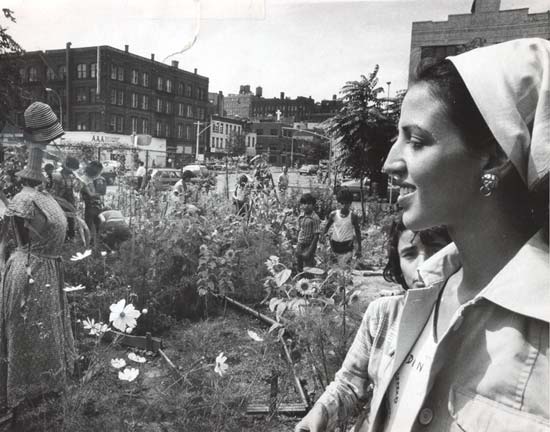By Nhu Nguyen, Education and Curriculum Development Intern

The idea of the Community Garden, as we know it today, conjures a space of raised wooden beds, of organized irrigation, and of cooperative greenery. However, when we look underneath the greenery, we realize these spaces were seeded from the concrete itself. During the fiscal crisis of the 1970s, abandoned buildings and lots dotted the New York landscape when many landlords sabotaged their own properties to avoid renovation costs and to collect insurance (Reynolds, 2015). Many Black and Latino activists, notably those in the Green Guerillas environmental nonprofit, organized to clean up and to start horticultural practices in lands that were unproductive from widespread urban neglect (History of the Community Garden movement, 2021). By turning vacant lots into spaces that invite community participation, the social and environmental organizing work of Black and Latino activists created the foundation for modern urban community gardens.
Today, the faces featured from urban agriculture look different. It looks young and entrepreneurial. It looks like expensive hydroponic indoor watering systems in skyscrapers, high above its roots on the concrete (“Urban Farms are growing amongst NYC’s Skyscrapers”, 2019). Urban Agriculture, on its face, looks white. In a New York Magazine article that highlighted a “new class of growers” (Stein, 2010), only one of the “young, idealistic and educated” farmers profiled was non-white. This, as Kristen Reynolds suggests, repainted Urban Agriculture as a mostly white and for-profit venture – “despite findings that despite findings that the majority of gardeners in the city’s nearly 1000 community gardens self-identify as African-American or Latino/a” (Reynolds, 2015). And when placed in application of financial and spatial inequalities, such ideas contribute to the devaluation of non-white gardens and their history.
While the urban agriculture movement is rooted in the efforts of Black and Latino communities, their horticultural labor have been used against them under racial capitalism. Community gardens beautify neglected landscapes where populations of color tend to be concentrated, and in turn, signal future investors to market the neighborhood as livable and green (McClintock, 2018). Further, urban agriculture’s entanglement in processes of gentrification is continued by historical and contemporary allotment of funding and land (Reynolds, 2015). Indigenous and Black-led horticultural practices have been framed as less “civilized”, and garden programs for Black citizens have been framed to focus more on “modernization” — subjecting these communities to the racial hierarchy that the founders of the movement sought to abolish (McClintock, 2018). These historical biases against communities of color contribute to the existing disparities between white-led urban agriculture versus POC-led urban agriculture (Reynolds, 2015). While community gardens remain a valuable medium to get fresh foods to the nearby community, we have to be critical on whether we’re seeking a trendy alternative, or if we’re working towards systemic change.
Sources:
McClintock, Nathan. (2018). “Urban agriculture, racial capitalism, and resistance in the settler‐colonial city”. Geography Compass. 12. 10.1111/gec3.12373.
Reynolds, Kristin. (2015). “Disparity despite diversity: Social injustice in New York City’s urban agriculture system.” Antipode 47.1 (2015): 240-259.
Stein J (2010). “What an urban farmer looks like”. New York Magazine 19 September. http://www.nymag.com/restaurants/features/68297/
The City of New York. “History Of The Community Garden Movement”. Nycgovparks.Org, 2021. Retrieved from: https://www.nycgovparks.org/about/history/community-gardens/movement.
“Urban Farms Are Growing Amongst NYC’s Skyscrapers”. (2019). Retrieved from: https://www.agritecture.com/blog/2019/1/23/urban-farms-are-growing-amongst-nycs-skyscrapers?fbclid=IwAR0Of9LsPogYETsEfgtyYQ-m1l6aTGm1nv_N0KtS4Xe5kG_lEI_I3Hpgo7U.



0 Comments